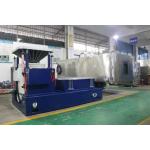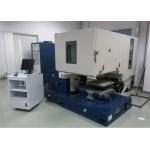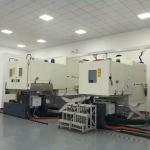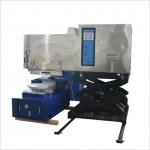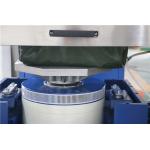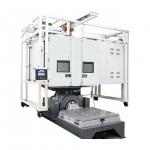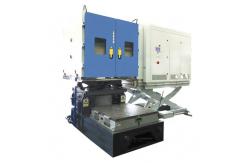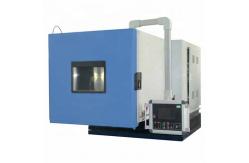In the ever-evolving landscape of environmental laboratory testing,
the demand for advanced and precise testing equipment has reached
new heights. The customized vibration table combined with a thermal
shock testing chamber represents a cutting-edge solution that
empowers industries to evaluate the resilience and performance of
their products under the most demanding and realistic conditions. This unique testing apparatus is designed to subject samples to
simultaneous or sequential vibration and thermal shock stresses. It
caters to a diverse range of industries, including aerospace,
automotive, electronics, and military. The primary objective is to
assess how products and materials respond to rapid temperature
changes and mechanical vibrations, which are common in various
real-world applications. By replicating these complex environmental
scenarios, manufacturers and researchers can identify potential
weaknesses, optimize designs, and ensure compliance with stringent
industry standards and regulations. - Robust and Modular Design
- The testing system is constructed with a heavy-duty steel frame
that provides exceptional stability and durability. The frame is
designed in a modular fashion, allowing for easy customization and
integration of different components. The vibration table and
thermal shock chamber can be adjusted and configured to accommodate
a wide variety of sample sizes and shapes. The modular design also
facilitates future upgrades and modifications, ensuring that the
equipment can adapt to evolving testing requirements.
- High-Performance Vibration Table
- The vibration table incorporated into the system is engineered for
precision and power. It can generate a wide range of vibration
frequencies, typically from 5 Hz to 2000 Hz, covering the spectrum
of vibrations encountered in many industrial applications. The
amplitude of vibration can be precisely controlled, ranging from a
few micrometers to several centimeters. The table is equipped with
a high-torque motor and advanced servo control system, ensuring
accurate and repeatable vibration patterns. It also features a
rigid surface and excellent dynamic balance, minimizing any
unwanted resonances or vibrations that could affect the test
results.
- Advanced Thermal Shock Testing Chamber
- The thermal shock chamber is designed to subject samples to rapid
and extreme temperature changes. It can achieve temperature
transitions from as low as -70°C to as high as +180°C within a
remarkably short time frame. The chamber utilizes a dual-zone
temperature control system, with separate hot and cold zones, and a
rapid transfer mechanism to move samples between the zones. This
enables the simulation of thermal shock conditions that occur, for
example, when a component moves from a hot engine compartment to a
cold external environment or vice versa. The chamber is also
equipped with high-quality insulation to maintain temperature
stability and prevent heat leakage.
- Synchronized Control and Data Acquisition
- The system features a sophisticated control panel that allows for
seamless synchronization of vibration and thermal shock parameters.
Operators can precisely program the sequence and intensity of
vibrations and temperature changes, creating custom test profiles.
The control panel also provides real-time monitoring of all test
parameters, including temperature, vibration frequency, amplitude,
and sample status. The data acquisition system records detailed
information about the test, such as temperature profiles, vibration
waveforms, and any changes in the physical properties of the
sample. The acquired data can be stored in a variety of formats and
analyzed using specialized software to generate comprehensive test
reports.
- Safety and Protection Mechanisms
- To ensure the safety of operators and the integrity of the testing
process, the system is equipped with a range of safety features. It
has emergency stop buttons strategically located for immediate
shutdown in case of any abnormal situation. The vibration table and
thermal shock chamber are enclosed in a protective housing made of
durable and heat-resistant materials. The housing is designed to
contain any potential flying debris or leaks from the chamber.
Additionally, the system has built-in safety interlocks that
prevent unauthorized access or operation when the equipment is in
use.
- Maximum Vibration Displacement
- The vibration table can achieve a maximum displacement of ±50 mm.
This significant displacement capacity allows for the simulation of
severe vibration conditions, such as those experienced during
off-road driving, earthquakes, or heavy machinery operation. For
example, in testing the durability of automotive suspension
components, a large vibration displacement can help uncover
potential weaknesses in the design or material under extreme
mechanical stress.
- Vibration Frequency Range
- As mentioned, the frequency range of 5 Hz to 2000 Hz covers a wide
spectrum of vibrations. Low-frequency vibrations can affect the
stability and alignment of larger structures, while high-frequency
vibrations can cause fatigue and failure in smaller, more delicate
components. Testing across this frequency range ensures a
comprehensive evaluation of a product's performance under different
vibration scenarios.
- Thermal Shock Temperature Range
- The ability to transition from -70°C to +180°C provides a broad
range of thermal shock conditions. This is crucial for industries
such as aerospace, where components may experience extreme
temperature differences between outer space and re-entry into the
Earth's atmosphere. In electronics, it helps assess the reliability
of components that may be exposed to rapid temperature changes
during operation or storage.
- Temperature Transition Rate
- The thermal shock chamber can achieve a temperature transition rate
of up to 30°C per minute. This rapid rate of temperature change is
essential for accurately simulating real-world thermal shock
events. For instance, in testing the integrity of a ceramic
insulator used in a high-power electrical device, a fast
temperature transition can reveal any cracks or weaknesses that may
develop due to thermal stress.
- Maximum Payload Capacity
- The system has a maximum payload capacity of up to 1000 kg. This
generous capacity allows for the testing of a wide range of
products, from small electronic modules to larger mechanical
assemblies. It enables manufacturers to test multiple components or
complete systems simultaneously, increasing testing efficiency and
providing a more accurate assessment of overall system performance.
|
